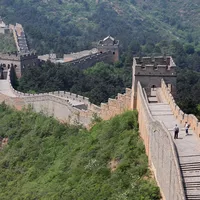×
We use cookies to help make LingQ better. By visiting the site, you agree to our
cookie policy.
UIowa Chinese Reading World - Beginning Level, 299 仓颉*造字
299 仓颉 *造字
仓颉 * 造字
很久以前 , 有 一个 叫 仓颉 的 人 。
他 非常 聪明 , 帮助 黄帝 * 记 国家 事情 。
开始 , 仓颉 把 一切 事情 都 记 在 自己 的 脑子里 。
后来 , 事情 越来越 多 , 越来越 复杂 , 只用 脑子 是 记不住 的 。
所以 仓颉 又 用 打 绳结 * 的 方法 来记 事情 , 他用 大结 代表 大事 , 小结 代表 小事 。
不久 , 仓颉 觉得 这个 方法 也 不是 很 好 , 因为 它 只能 告诉 他 曾经 有 事情 发生 , 但是 不能 把 前人 的 经验 和 知识 传给 后代 *。
一天 , 仓颉 在 树林 中 听到 几个 猎人 * 的 对话 *。
一个 说 :“ 你 猜 这会 是 什么 脚印 *?
” 另 一个 猎人 说 :“ 你 看 这部分 又 窄 又 长 , 我 看 多半 是 鸟儿 的 爪印 *。
” 又 有 另 一个 声音 :“ 胡说 , 你 看看 这边 , 又 弯 又 急 , 应该 是 狐狸 * 的 脚印 才 对 。
” 没想到 , 他们 的 对话 却 启发 了 仓颉造 字 的 方法 。
仓颉 开始 研究 鸟儿 的 爪印 和 动物 的 脚印 等 自然现象 , 创造 出 代表 他们 的 独特 * 符号 *, 并 把 这些 符号 称为 “ 字 ”。
299 仓颉 *造字
Cangjie|creating characters
299 Cangjie* character creation
299 Creación del personaje Cangjie
299 Cangjie* karakter oluşturma
仓颉 * 造字
Cangjie|creating characters
倉頡*が作ったキャラクター
很久以前 , 有 一个 叫 仓颉 的 人 。
A long time ago||||Cangjie||
A long time ago, there was a man named Cangjie.
他 非常 聪明 , 帮助 黄帝 * 记 国家 事情 。
||smart|helped the Yellow Emperor|Yellow Emperor|record|state affairs|state affairs
He was very smart and helped Huangdi * remember the country.
开始 , 仓颉 把 一切 事情 都 记 在 自己 的 脑子里 。
start|Cangjie||everything|||remembered|||possessive particle|in his mind
后来 , 事情 越来越 多 , 越来越 复杂 , 只用 脑子 是 记不住 的 。
|things|more and more|||complicated|only use|brain||can't remember|
所以 仓颉 又 用 打 绳结 * 的 方法 来记 事情 , 他用 大结 代表 大事 , 小结 代表 小事 。
|||||knot||method|to record|events||big knot|representative||small matters||small matters
不久 , 仓颉 觉得 这个 方法 也 不是 很 好 , 因为 它 只能 告诉 他 曾经 有 事情 发生 , 但是 不能 把 前人 的 经验 和 知识 传给 后代 *。
|Cangjie|||method||||||||tell||once|||happened||||ancestors||experience|||pass on|future generations
一天 , 仓颉 在 树林 中 听到 几个 猎人 * 的 对话 *。
|||forest||heard||hunters||
One day, the barn owl heard the conversation of several hunters * in the woods *.
一个 说 :“ 你 猜 这会 是 什么 脚印 *?
||you|guess|this meeting|||footprint
One said, "Guess what footprint it would be *?
” 另 一个 猎人 说 :“ 你 看 这部分 又 窄 又 长 , 我 看 多半 是 鸟儿 的 爪印 *。
||hunter||||this part||narrow||long||look|most likely||bird||bird claw print
"Another hunter said," You see this part is narrow and long. I think it's mostly the bird's paw print *.
” 又 有 另 一个 声音 :“ 胡说 , 你 看看 这边 , 又 弯 又 急 , 应该 是 狐狸 * 的 脚印 才 对 。
||||voice|Nonsense|||this side||curved||sharp|||fox||paw print|emphasis particle|correct
There was another voice: "Nonsense, look at this side, it's crooked and anxious, it should be the footprint of the fox *.
” 没想到 , 他们 的 对话 却 启发 了 仓颉造 字 的 方法 。
unexpectedly|||dialogue||inspired||Cangjie script|||
仓颉 开始 研究 鸟儿 的 爪印 和 动物 的 脚印 等 自然现象 , 创造 出 代表 他们 的 独特 * 符号 *, 并 把 这些 符号 称为 “ 字 ”。
||study|birds||claw prints||animals||||natural phenomena|create||representatives|||unique|characters|and|||characters|called|characters

